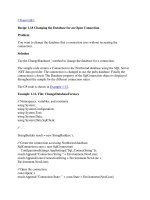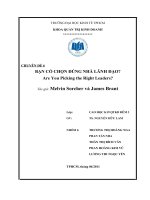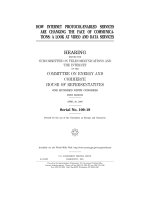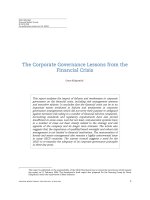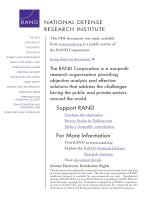IT governance publishing changing the IT leaders mindset 2010 RETAiL EBook
Bạn đang xem bản rút gọn của tài liệu. Xem và tải ngay bản đầy đủ của tài liệu tại đây (3.06 MB, 169 trang )
Changing the IT Leader’s Mindset
Time for revolution rather than evolution
Changing the IT Leader’s
Mindset
Time for revolution rather than
evolution
ROBINA CHATHAM AND
BRIAN SUTTON
Every possible effort has been made to ensure that the information
contained in this book is accurate at the time of going to press, and the
publishers and the author cannot accept responsibility for any errors or
omissions, however caused. No responsibility for loss or damage
occasioned to any person acting, or refraining from action, as a result of
the material in this publication can be accepted by the publisher or the
author.
Apart from any fair dealing for the purposes of research or private
study, or criticism or review, as permitted under the Copyright, Designs
and Patents Act 1988, this publication may only be reproduced, stored
or transmitted, in any form, or by any means, with the prior permission
in writing of the publisher or, in the case of reprographic reproduction,
in accordance with the terms of licences issued by the Copyright
Licensing Agency. Enquiries concerning reproduction outside those
terms should be sent to the publishers at the following address:
IT Governance Publishing
IT Governance Limited
Unit 3, Clive Court
Bartholomew’s Walk
Cambridgeshire Business Park
Ely
Cambridgeshire
CB7 4EH
United Kingdom
www.itgovernance.co.uk
© Robina Chatham and Brian Sutton 2010
The author has asserted the rights of the author under the Copyright,
Designs and Patents Act, 1988, to be identified as the author of this
work.
First published in the United Kingdom in 2010
by IT Governance Publishing.
ISBN 978-1-84928-066-2
FOREWORD
This book is a real breath of fresh air!
As leadership has gradually overtaken technical expertise as
the barometer of an outstanding head of IT, I have read
every book out there on the subject. None has provided
such a useful and pertinent guide to perfecting leadership
and interpersonal skills.
Changing the IT Leader’s Mindset is engaging, clear and
packed with practical advice. Reading this book will get
you thinking about how you influence people and unite
them in common purpose to deliver a strategic vision.
For those of you who wish to take a seat at the Boardroom
as a peer to the other business leaders, this book is a mustread, providing insight on personal branding, innovation
and how to gain Board-level recognition.
Cathy Holly
Partner
Boyden Global Executive Search & Interim Management
5
PREFACE
This book is about transforming the IT leader’s mindset –
from one of victim to one of victor. It is dedicated to the
many IT leaders we have known and worked with who feel
undervalued, unappreciated and often simply ignored.
You may not like or agree with all that we say in this book,
because it is in the nature of the IT professional to share a
sensitivity to criticism. However, if we are serious about
changing our behaviour for the better, we have to accept
some painful truths.
We have written this book for the busy executive; it is
punchy, pithy, poignant and powerful. We have kept it
short, illustrated it with many models and tables and tried to
point to simple practical steps that you can take to change
the way that you operate and are perceived by others.
The principal research referred to in the text has been
undertaken by us during our work with major organisations
in the UK and abroad. We are in the business of
management development and this book is the fruit of our
experience in helping real IT leaders develop their
Transformational Leadership capability.
Unlike the majority of books on IT leadership we do not try
to reduce the solution to a process or procedure; our focus
is on an understanding of human nature and evolutionary
psychology; the development of Emotional Intelligence and
the ability to embrace ambiguity and complexity.
This book will show you how to take the great ideas of the
last 10 years and make sense of them in a way that will help
6
Preface
you make the transition
Transformational Leadership.
from
Robina Chatham and Brian Sutton
7
Transactional
to
ABOUT THE AUTHORS
Dr Robina Chatham has 14 years’ experience in IT,
culminating with the position of CIO for a leading merchant
bank. She is qualified as both a mechanical engineer and a
neuroscientist. In the year 2000 she co-authored Corporate
Politics for IT Managers: How to get Streetwise, published
by Butterworth Heinemann. In the words of the Chief
Executive of the British Computer Society: ‘If a fraction of
those who read the book do something positive with the
ideas presented, the state of UK plc will be forever
enriched’. She has also written a number of book chapters,
numerous academic papers and articles for trade journals
and magazines. She is a visiting fellow at Cranfield School
of Management and also runs her own training consultancy
specialising in helping senior IT managers to develop
political acumen, to master the art of influencing others and
hence increase their personal impact at Board level. In 2008
she was voted a medallist for the BCS IT Industry IT
Consultant of the Year award. She is a regular keynote
presenter at IT practitioner conferences.
Dr Brian Sutton has over 30 years’ experience of running
engineering and IS projects, having managed major
initiatives and projects varying in size from hundreds of
thousands of pounds to tens of millions of pounds. He has
developed comprehensive IS strategies, conducted largescale reengineering initiatives and led major organisational
change. He regularly contributes articles to professional
journals and speaks at major professional gatherings. He
holds a doctorate in corporate education and a master’s
8
About the Authors
degree in information systems design from the London
School of Economics and has worked extensively in both
the private and public sectors in the UK, Europe and the
United States. He was formerly a professor of systems
management in the Information Resources Management
College of the National Defense University in Washington,
DC and is currently a visiting professor with the Institute
for Work Based Learning at Middlesex University.
ACKNOWLEDGEMENTS
The following people have generously given of their own
time by reviewing this publication:
Ajay Burlingham-Böhr, MBA, FBCS, CITP, FRSA,
Director of Information Systems and Media Services,
Anglia Ruskin University.
Cathy Holly, Partner, Boyden Global Executive Search &
Interim Management.
Mart Rovers, President, InterProm USA.
Mandar Sahasrabudhe, Manager, Information Security
Persistent Systems Pte. Ltd, Singapore.
9
CONTENTS
Part I Where We Are Now and Why We See the World
the Way We Do ............................................................. 13
Chapter 1: Surviving in a World of Change ................ 14
Possible futures and consequences ............................... 16
So where are we? ......................................................... 18
Why we think and act the way we do ........................... 21
Transactional vs Transformational Leadership ............. 27
Reflection .................................................................... 31
Food for thought .......................................................... 31
Chapter 2: The IT Stereotype and its Implications ..... 33
Psychological characteristics of IT people .................... 35
What are the consequences of the IT stereotype?.......... 38
The way forward.......................................................... 40
Reflection .................................................................... 41
More food for thought .................................................. 42
Chapter 3: The Illusion of a Solution ........................... 43
The route from IT leader to CEO – critical attributes.... 45
Reflection .................................................................... 49
More food for thought .................................................. 50
Chapter 4: Insights from Evolutionary Psychology..... 51
Behavioural hardwiring – the implications for IT ......... 53
In conclusion................................................................ 59
Reflection .................................................................... 60
More food for thought .................................................. 60
Chapter 5: New Models of Leadership – The Route to
Becoming a Transformational Leader ......................... 61
Understanding that process and practice are not the same
thing ............................................................................ 62
10
Contents
Summary – Transactional vs Transformational
Leadership traits........................................................... 67
Reflection .................................................................... 68
More food for thought .................................................. 68
Part II Building Transformational Competencies ....... 69
Chapter 6: Releasing the Power of the Many .............. 70
Learning to see anew.................................................... 71
A framework for shaping the environment ................... 73
Alignment .................................................................... 73
Congruence.................................................................. 77
Co-creation .................................................................. 79
Engaged stakeholders................................................... 81
Shared responsibility.................................................... 84
Self-selection ............................................................... 89
Building the conditions that promote innovation .......... 92
Key ideas from this chapter.......................................... 94
Reflection .................................................................... 95
More food for thought .................................................. 96
Chapter 7: Changing the Way We Think and Talk
about Work ................................................................... 98
Start at the end and work backwards ...........................100
The power of igniting purpose.....................................102
Building purpose through future-focused conversations
...................................................................................104
Structuring your conversations ....................................108
Key ideas from this chapter.........................................115
Reflection ...................................................................116
More food for thought .................................................117
Chapter 8: Future-Focused Communication ..............118
Adapting your communication style to the language of the
receiver .......................................................................122
11
Contents
Communicating with the types ....................................124
Being sensitive to the needs of others..........................127
Adding an extra dimension..........................................130
E-mail communication ................................................132
Writing reports............................................................133
Key ideas from this chapter.........................................134
Reflection ...................................................................135
More food for thought .................................................136
Chapter 9: Delivering Lasting Change .......................137
Some classic reasons for lack of success in change
initiatives ....................................................................139
Tactics to use to become a lightning conductor for change
...................................................................................145
Key ideas from this chapter.........................................153
Reflection ...................................................................153
More food for thought .................................................154
Chapter 10: Taking a Holistic View ............................156
Learning to ‘Be’ different............................................157
Key steps on the journey .............................................159
Four levels for you to work on ....................................162
Final words .................................................................166
ITG Resources..............................................................167
12
PART I
WHERE WE ARE NOW AND WHY WE SEE THE
WORLD THE WAY WE DO
13
CHAPTER 1: SURVIVING IN A WORLD OF
CHANGE
In 1859, Charles Dickens began his Tale of Two Cities with
the words: ‘It was the best of times, it was the worst of
times, it was the age of wisdom, it was the age of
foolishness’.
He could have been writing about the plight of IT leaders –
they, too, face an uncertain future and have little in the way
of tradition or track record to fall back on. In their short
history, IT leaders have enjoyed many titles; recently there
has been a trend towards the epithet ‘chief information
officer’ (CIO) – as recently as the 1980s this term was
unheard of and, in most instances, the incumbent never
really embraced the I of information, but rather concentrated
on the T of technology, and therefore assumed the default
position of CTO – chief technology officer. Indeed, many
IT leaders, whatever their role name, have a tendency to
become bogged down in the technical aspects of the role.
This has consequences, not least of which is that they tend
to spend a lot of time dealing with challenging questions
such as:
· Why is IT so expensive?
· How can we reduce our IT costs?
· Why did our major supply chain rationalisation project
overrun on budget and deliver late?
· Why is it that we have doubled our investment in IT over
the last five years, but have seen no improvement in
productivity?
14
1: Surviving in a World of Change
· Why do I read about other companies transforming their
performance through the use of latest Web 2.0
technologies, but we appear to be stuck in the last
century?
It is difficult to be influential when you are constantly on
the back foot justifying your very existence. IT leaders
rightly believe that they can, and should, influence the
strategic use of information technology to drive new levels
of business performance. However, all too often they have
little or no voice when it comes to strategy decisions;
indeed, less than half of all IT leaders are members of
operational boards and only about 30% report directly to
the CEO.1
So what is the future for the IT leader – is it to be the worst
of times, a retrenchment to the mechanic’s role of chief
technology officer, consigned like Star Trek’s ‘Scotty’ to
the bowels of the engine room and destined never to go on
an away mission? Or will they model themselves on
Captain Kirk and boldly go where no IT leader has gone
before, on their continuing mission to discover brave new
business models and enable technology-led business
opportunities previously unimagined? If they take this new
route, the IT leader could evolve into the CTO – chief
transformation officer – and really contribute to the
development and success of their business enterprises.
Our contention is that, whilst this change may appear to be
evolutionary in terms of technical skills and contribution, if
it is to happen, it will require a revolutionary change in
attitude, perception and relationship structures. The good
1
Harvey Nash, 2009 IT Leadership Report; a survey of 1,345 CIOs across Europe.
15
1: Surviving in a World of Change
news is that this is all possible and it is firmly in their own
hands. In this book we will provide access to the
understanding necessary to develop the reflective capacity
to shape the journey, along with a range of tools and
techniques that can be used to navigate along the way.
Possible futures and consequences
Influential management thinkers, such as C.K. Prahalad,2
argue that the very shape of business is changing, and that
to be successful we need to rethink business models and
relationships with customers, suppliers and partners.
Specifically, he suggests that:
· The way companies create value is shifting from
products to solutions to experiences.
· At any given time, the people best equipped to solve our
most pressing problems probably work for somebody
else. Therefore, to be successful we need mechanisms
that allow us to access the talent, materials, products and
services from the best source, wherever that is in the
globe. This realisation is at the heart of the current shift
towards Open Innovation in many organisations.
· Both internal management systems and current IT
infrastructures are the largest obstacles to success in the
new world.
These first two ideas and the recognition of the power of
the third inhibitor have the potential to reshape our
industries. Perhaps surprisingly, the early indicators are not
2
C.K. Prahalad and M.S. Krishnan, The New Age of Innovation; Driving Co-created
Value through Global Networks, McGraw Hill (2008).
16
1: Surviving in a World of Change
just that it is information-intensive sectors that are
embracing these changes, but also that traditional heavymanufacturing giants are leveraging the power of
individualised services and global partnering and sourcing.
At the core of this transition, is a move away from
segmenting consumers in classes based upon average
demographics towards engaging on an individual basis with
a consumer around their individual needs and behaviours,
and then co-creating a value proposition directly with that
consumer. The implications of operating in this way are
significant and, as a minimum, demand:
· flexibility – the ability to reconfigure resources (from
both internal and external sources) to dynamically meet
demand
· collaboration – networks of partner-providers and
solution-finders – a model that moves away from
ownership to a world of privileged access and influence
· improved decision making – in order to allocate
resources dynamically to meet changing patterns of
demand and one-to-one relationships with customers, we
need real-time, reliable analytics, so that managers can
move from intuition-based decisions to fact-based
decisions
· open access – the right resource from the right source at
the right time – shifting the thinking from who is
available in the department to who is available in the
world. The focus is, therefore, on access and influence,
rather than on ownership and control.
An underpinning assumption in the trends outlined above,
is that in terms of value creation, the power of IT lies not in
its capacity to enable more joined-up transactions
17
1: Surviving in a World of Change
processing across diverse supply chains, but rather in its
ability to support decision making around the deployment
of resources to dynamically meet changing business
patterns. In this respect, we need a renewed focus on the I
in IT – a world where we use information to transform and
enable new modes of value creation, rather than using
information (data) to transact existing business and value
chains. When we look at those organisations that stand out
as leaders in the application of technology to enable new
business models, we see nimble and highly flexible entities
who are comfortable with risk and uncertainty and who
frequently experienced many setbacks and failures before
becoming overnight successes. Anyone in the research and
development business will testify that every market-leading
product is built on the back of a series of failures, probably
a ratio in excess of 10 to one. However, many IT leaders
behave as if this statistic doesn’t apply to IT systems
development. They appear to believe that they can find the
right solution first time every time and that, if we can only
improve our analysis and planning, we can bring every
solution into operation. This is patently nonsense. In order
to get new and innovative solutions, we need to constantly
experiment, we need to provide an incubation environment
for breakthrough ideas and solutions and we need to
tolerate failure, as long as we learn from it.
We would, therefore, argue that in the modern world the IT
leader needs to be a master of imperfectly seizing the
unknown, rather than working to perfect the known.
So where are we?
For well over 20 years, there have been clarion calls for IT
directors and CIOs to produce an IT strategy that is linked
18
1: Surviving in a World of Change
to the business strategy and supportive of desired business
outcomes. When such a clear and explicit linkage is not
evident, the excuse is often that the business strategy is illdefined or shifting, or that it is out of phase with the needs
of the IT planning cycle. Yet such claims misunderstand the
nature of strategy formulation. In the 1960s and 70s, it was
not unusual for large organisations to have a staff function
whose remit was strategic planning, a constant scanning of
the environment and the articulation of long-term plans and
goals. Now, however, these staff functions are largely
defunct. Strategy is seen to be a ‘wicked problem’3 – these,
by definition, are problems that have no clear cause-andeffect relationships and tend not to submit themselves to
analytical solutions. In such circumstances, strategy is seen
as dynamically emerging through a process of ongoing and
open dialogue between all stakeholders, as opposed to the
product of an élite and gifted few.
So we have a situation where business strategy now tends
to emerge through a process of ongoing dialogue in
response to ill-defined, dynamic and often unpredictable
market conditions. Many IT leaders have no voice in this
ongoing dialogue because they have not established a
sufficiently wide sphere of influence based on trust and
personal credibility. They are not keyed into the
organisational network, and their introspective focus on
technology often leads to them being labelled as having no
business acumen.
3
John. C. Camillus, ‘Strategy as a Wicked Problem’, Harvard Business Review (May
2008). Wicked problems are problems with many stakeholders with differing values and
priorities. Their roots are complex and tangled, and the nature of the problem changes
with every attempt to address it. These types of challenge are unprecedented, and
therefore there is nothing to indicate the right answer to the problem.
19
1: Surviving in a World of Change
It is a given that the IT leader must be technically capable
and keyed in to emerging trends and technologies; they
must also be keyed in to the latest business thinking in a
wide range of industries, keyed in to how business models
are developing and the role of technology in enabling those
business models. These qualities are hygiene factors – they
are must-haves, they represent a licence to practise.
However, relationship-building, strategic influencing,
consensus-building,
leading
through
conversations,
communication, negotiation, networking, stakeholder
management – these are the skills that make a difference,
open doors and provide a licence to transform.
It is becoming clear that effective IT leadership needs a
blend of hard techniques and excellent people skills.
Traditionally, IT professionals have been stereotyped as
having poor interpersonal and communication skills – this
may or may not be true, but what is certainly true is that
success in the future requires a lot more than technical
excellence. The IT leader of the future will be focused on
business issues and, in order to be effective, must be part of
a broader coalition of leaders who, together, find innovative
ways to drive business value and create sustainable
advantage. A recent survey of 1,345 CIOs across Europe
revealed what they deemed to be key skills in a downturn
(see Figure 1).
20
1: Surviving in a World of Change
Skills deemed more important in a downturn
70%
60%
50%
40%
30%
20%
10%
Managing the
detail
Being
consultative
Empowering
your team
Undertak ing
more strategic
planning
Showing direct
leadership
Being
transparent
Leading by
example
Being
communicative
0%
Figure 1: Critical skills for IT leaders
Interestingly, in their view of key skills there is no mention
of technical excellence, adoption of best practice, or ability
to carry out benchmarking and raise process standards. The
focus is very much on working through people and
relationships to provide leadership. The only tangible skill
mentioned was managing the detail, and this from only
around 10% of respondents. These findings just confirm
that technical excellence only gets you so far; the really
hard stuff is the soft stuff. So why do we find it so difficult
to create open, transparent relationships with our peers that
promote collaborative action and collective discovery?
Why we think and act the way we do
It is tempting to assume that there is just one shared reality
and that, when we witness something, everyone else sees
the same thing, takes away the same facts and is left with
21
1: Surviving in a World of Change
the same impressions. Actually, around 80% of the data we
use to make decisions is already in our heads before we
engage with a situation. Our power to perceive is governed
and limited by cognitive filters, sometimes termed our
‘mental model’. Mental models are formed as a result of
past experience, knowledge and attitudes. They are deeply
ingrained, often subconscious, structures that limit what we
perceive and also colour our interpretation of supposed
facts. Each person has a different mental model and,
therefore, potentially a different interpretation of the Facts.
The danger comes when we start to assume that our
interpretation of the Facts is the only interpretation and we
believe that what we see and think is the Truth, and that
there is only one Truth.
Recent research in neuroscience suggests that we deal with
information overload using what might be termed ‘pattern
recognition’. When presented with a new situation, our
brain will seek to find a pattern based upon prior
experience. Further, our brain is highly tuned to this task
and will find a pattern even when the information is very
sparse. Once we have found a match, we tend to become
wedded to that view, even though subsequent information
may contradict our initial assessment. It would appear, then,
that the brain relies for decision making on two hard-wired
processes:4
· our brains assess what is going on using pattern
recognition; and
· we react to what is going on because of ‘emotional tags’
that are stored in our memories.
4
Andrew Campbell, Jo Whitehead and Sydney Finkelstein, ‘Why Good Leaders Make
Bad Decisions’, Harvard Business Review (February 2009).
22
1: Surviving in a World of Change
These ideas complement work done by the Swedish
neurobiologist David Ingvar, where he proposes a concept
which he terms ‘memories of the future’.5 Ingvar suggests
that the human brain is constantly involved in futurefocused action-planning. We mentally rehearse possible
futures based upon the information that is available to us;
these possible future plans can have either positive or
negative outcomes. Our brains store these patterns as a sort
of memory of things that have not yet happened. Thus,
when our brain looks for patterns as a result of a new
situation, it could match with a real memory or with one of
these possible future memories. The main purpose of
‘memories of the future’ is, therefore, as an aid to pattern
recognition in so far as incoming information is only
deemed to be meaningful if it matches one of our stored
alternative paths into the future.
These two pieces of work from the field of neuroscience
suggest that far from acting upon what we see, we only see
what we deem to be relevant and supportive of things we
already know: our stored view of how things work. Our
mental models ensure that what we perceive is governed
more by what is already in our head than what is in front of
our eyes.
Whether you call these neural pathways ‘mental models’ or
‘memories of the future’, what is clear is that they are
deeply-held views of the way that the world works or
should work. At a subconscious level, these models may be
largely hidden from ourselves; we react apparently
instinctively as a result of deeply hidden views that we are
5
David Ingvar, The Memory of the Future, referenced in Arie P. de Geus, ‘Why Some
Companies Live to Tell about Change’, Journal of Quality and Participation (July–
August 1998).
23
1: Surviving in a World of Change
not aware of and could probably not articulate if asked.
Because of this, mental models are difficult to shake or
change. We are all prisoners of our past experience; we
view the present through the lens of the past.
Why is this important? Well, there is an old expression that
goes along the lines of:
If you always do what you always did, you will always get what
you always got.
The truth in this statement is that much of what our eyes see
is discarded by the brain as irrelevant because it does not fit
with currently-stored patterns. Our brain will find a pattern,
but there is no guarantee that it will be the right pattern. Our
ability to perceive is governed by our mental model, and the
range of possible actions is prescribed by what we perceive
and our standard models of assessment. This means that
most of us spend most of our time locked into what might
be termed a ‘Do–Get loop’ (see Figure 2).
What we perceive
(see), how we react
(assess), is limited by
what is already in our
heads and prescribes
Assess
our range of possible
actions.
Do
See
Most of the time we
focus on what we ‘do’
Get
and the results we ‘get’.
We keep busy ‘doing’
more and more of the
same thing.
Figure 2: How mindset limits our options for action
24
1: Surviving in a World of Change
Our past (mental model) governs what we perceive (See)
and how we make sense of it (Assess). This, in turn,
prescribes our range of possible actions (Do), which leads
to results (Get). We are therefore trapped into repeating
well-understood, but possibly ineffective, patterns of
behaviour and can Get sub-optimal results. The cycle is
both self-fulfilling and self-reinforcing – we tend to apply
the same assessment techniques to review what we get, thus
further reinforcing our mental model and further limiting
our ability to perceive the unusual or the remarkable.
Our mental model governs what we see, how we think
about things and how we act, but is this just an individual
phenomenon, or can whole communities and professions
share a common mental model, a shared view of reality?
This is a tricky area, and much like other collective
phenomena, such as organisational learning, there is no
clear consensus of opinion. What is beyond doubt is that all
professions have their own vocabularies, lexicons, tools and
techniques. These models, techniques and ways of
analysing things are not value-free; they represent a way of
seeing the world. When we select and use them we are
subconsciously buying into that way of thinking and,
inevitably, we are also reinforcing our own mental model of
cause and effect. We tend to expend significant effort in
understanding the inner workings of a new tool or practice,
but we give scant attention to the thought paradigm that
underpins it. Like it or not, knowingly or not, we all as IT
professionals subscribe, to some extent, to a common
mental model of how the world works. This model is
encapsulated in our techniques for analysing and
documenting our organisations and systems. It finds its way
into our modes of working and thinking and is enshrined in
25
